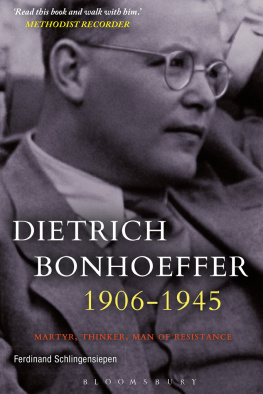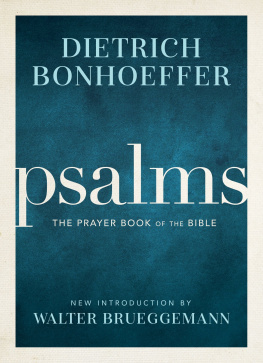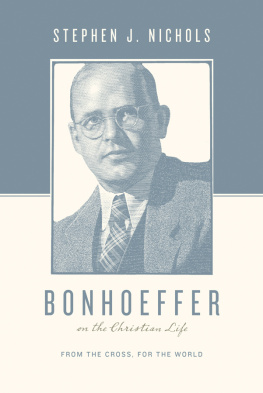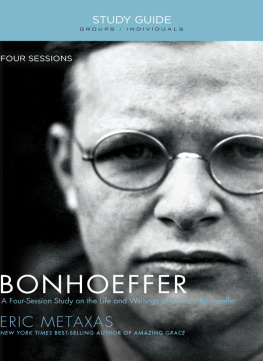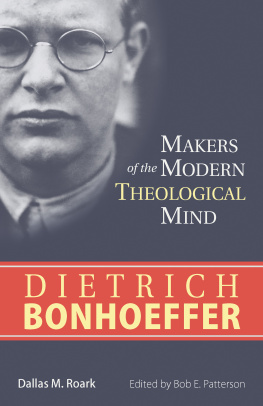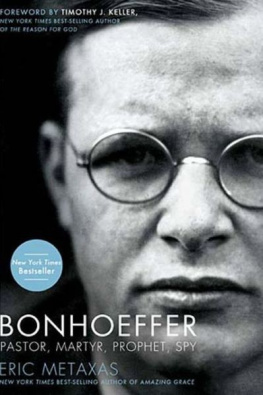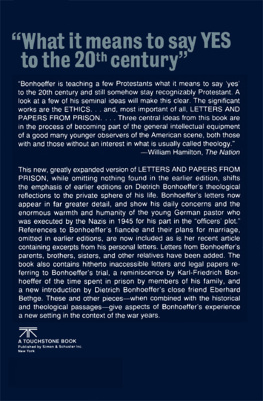TAKING STOCK OF BONHOEFFER
For DGH
wie eine Burg, in die nach Gefahr und Verwirrung
der Geist zurckkehrt,
in der er Zuflucht, Zuspruch und Strkung findet,
ist dem Freunde der Freund.
Like a fortress, where the spirit returns
after confusion and danger,
finding refuge, comfort, and strength,
such is the friend to the friend.
Dietrich Bonhoeffer, 1945
(DBW 8, p. 588; DBWE 8, p. 529)
Taking Stock of Bonhoeffer
Studies in Biblical Interpretation and Ethics
STEPHEN J. PLANT
Trinity Hall, Cambridge, UK
ASHGATE
Stephen J. Plant 2014
All rights reserved. No part of this publication may be reproduced, stored in a retrieval system or transmitted in any form or by any means, electronic, mechanical, photocopying, recording or otherwise without the prior permission of the publisher.
Stephen J. Plant has asserted his right under the Copyright, Designs and Patents Act, 1988, to be identified as the author of this work.
Published by
Ashgate Publishing Limited
Wey Court East
Union Road
Farnham
Surrey, GU9 7PT
England
Ashgate Publishing Company
110 Cherry Street
Suite 3-1
Burlington, VT 05401-3818
USA
www.ashgate.com
British Library Cataloguing in Publication Data
A catalogue record for this book is available from the British Library.
The Library of Congress has cataloged the printed edition as follows:
Library of Congress data has been applied for.
ISBN 9781409441052 (hbk)
ISBN 9781409441069 (pbk)
ISBN 9781409441076 (ebk-PDF)
ISBN 9781409471196 (ebk-ePUB)
Contents
Preface
With the exception of , which is published here for the first time, the essays collected in this volume have all been published before. These essays represent over two decades of my engagement with Bonhoeffers life and writings: I wrote the first as a research student in 1988 and the last was published in 2013.
I first read Bonhoeffer for an undergraduate essay in 1985. Knowing a little of Bonhoeffers reputation I invested in a copy of his Letters and Papers from Prison. The day before my essay was due in I had an appointment to have injections in preparation for a trip to the Indian subcontinent (a trip, I did not know at the time, that Bonhoeffer longed to make in the days before air travel made it possible for a student to do in his Christmas vacation). At the Tropical Diseases Clinic I reached the beautiful and startlingly creative letters written by Bonhoeffer in July 1944. I was, at this point, in the second year of a degree in theology; but I date my theological awakening from this moment. Something in Bonhoeffers letters took hold of all my attention and I missed my name being called. After rescheduling my appointment I read on well into the night and finished the book at a single sitting.
Nonetheless, Bonhoeffer was not my first choice of topic when I came to frame a proposal for doctoral research in 1987. I worked on Gregory of Nyssa for half a year before changing to Bonhoeffer. At that time, to the best of my knowledge, I was one of only two students undertaking Bonhoeffer research in the UK (the other was the late Jrg Rades at St Andrews, from whom I learned a great deal). Bonhoeffer was damned by association at that time with the radical theologies of the 1960s and was regarded by many as theological fast-food, his writings not substantial enough as objects of serious study. The revival of interest in his work is in large part a result of the publication between 1986 and 1999 of the 17-volume Dietrich Bonhoeffer Werke by Chr. Kaiser Verlag and, from 1996, of the 16-volume Dietrich Bonhoeffer Works in English. But it is also and more simply because, while other theologians and theological fashions have come and gone, Bonhoeffers theology has continued to speak urgent and important truths to the Church and the world.
Because these essays span over two decades, changes in my writing style, my understanding of Bonhoeffer and my personal theological perspective are observable in them. Yet, as I considered collecting them together, I was struck by common focal points, particularly Bonhoeffers use of the Bible and his commitment to making connections between theology and ethics. In my doctoral studies I tried unsuccessfully in the main to write about both these subjects and they have continued to occupy me since that first reading at the clinic in Birmingham, to the present moment. The essays differ further with respect to the varied audiences for whom they were written, from the simple bold brush-strokes suited to a national broadsheet newspaper, to the much more technical and painstaking writing suitable for a German academic volume. Through them all, I can see the extent to which I have been Bonhoeffers theological apprentice.
The most obvious question facing a writer collecting such diverse texts is the extent to which they should be revised; the answer that has seemed most sensible in this case is: as little as possible! I have, therefore, limited myself to changes of two kinds in re-presenting these essays. Firstly, I have updated all references to and all translations of Bonhoeffers writings to either the DBW or the DBWE or to both. This is not only because the new editions in German and English are of the finest quality taken as a whole, but because it makes sense to help readers chase up references in the most recent editions.
The second type of change I have made is to take out, for the sake of clarity, any references that made sense in the context in which the essay first appeared but will not make sense in this new context. Otherwise I have left the essays exactly as they first appeared, with all their blemishes.
Over the years I have worked on these essays I have incurred more intellectual and personal debts than I can properly acknowledge, but I want to single two out. In June 1989, shortly before the changes that would end with the unification of Germany, I visited the late Dr Martin Kuske in Teterow, a pretty little town in Mecklenberg-Western Pomerania. Dr Kuske was the author of an important monograph on Bonhoeffers understanding and use of the Old Testament that opened several avenues of enquiry for me. Dr Kuske was a busy man but parted with his day off to spend it with me though at the time my German was poor and his English even poorer. Together we went to Gstrow, some 20 miles away, where we visited the Ernst Barlach centre and the Gstrower Dom. This was my first encounter with the work of Ernst Barlach (18701938) and it left a permanent mark on my imagination. Barlach, like Bonhoeffer, fell foul of Nazi ideology when his work was condemned as degenerate in 1937; 381 pieces of his work were compulsorily removed from German galleries and museums and many were destroyed. A number churches also removed war memorials by Barlach. Among the pieces I saw with Martin Kuske was the Lesender Klosterschler, carved from wood in 1930. This calmingly symmetrical carving is of a novice reading a book alone (might it be the Bible?) with complete attention and composure. In 1932 Barlach cast in bronze Lesende Mnche (now in the Chicago Art Institute) in which two monks read and discuss a book together. As Bonhoeffer knew, reading the Bible alone and reading it together are both essential parts of the Christian life. This, taken together with my memory of the wisdom and generosity of Martin Kuske, explains the choice of cover for this book.
Without doubt the individual who has taught me most about Bonhoeffer is Clifford J. Green. I got to know him first in Heidelberg in the summer of 1990 when he was working on the manuscripts of Bonhoeffers Ethics for the new volume 6 in the
Next page

